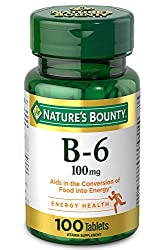Vitamin B6
Always consult your primary physician when starting a nutrition program with Vitamin B6.

Vitamin B6 is a water-soluble vitamin that is naturally present in many foods, added to others, and available as a dietary supplement. It is the generic name for six compounds (vitamers) with vitamin B6 activity: pyridoxine, an alcohol; pyridoxal, an aldehyde; and pyridoxamine, which contains an amino group; and their respective 5’-phosphate esters. Pyridoxal 5’ phosphate (PLP) and pyridoxamine 5’ phosphate (PMP) are the active coenzyme forms of vitamin B6 [1,2]. Substantial proportions of the naturally occurring pyridoxine in fruits, vegetables, and grains exist in glycosylated forms that exhibit reduced bioavailability [3].
Vitamin B6 in coenzyme forms performs a wide variety of functions in the body and is extremely versatile, with involvement in more than 100 enzyme reactions, mostly concerned with protein metabolism [1]. Both PLP and PMP are involved in amino acid metabolism, and PLP is also involved in the metabolism of one-carbon units, carbohydrates, and lipids [3]. Vitamin B6 also plays a role in cognitive development through the biosynthesis of neurotransmitters and in maintaining normal levels of homocysteine, an amino acid in the blood [3]. Vitamin B6 is involved in gluconeogenesis and glycogenolysis, immune function (for example, it promotes lymphocyte and interleukin-2 production), and hemoglobin formation [3].

